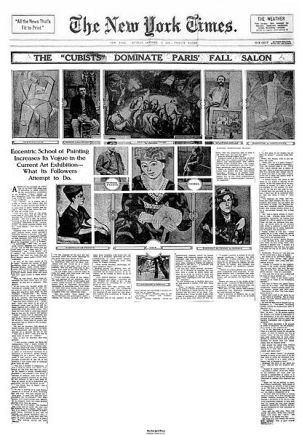There was a distinct difference between Kahnweiler’s Cubists and the Salon Cubists. Prior to 1914, Picasso, Braque, Gris and Léger (to a lesser extent) gained the support of a single committed art dealer in Paris, Daniel-Henry Kahnweiler, who guaranteed them an annual income for the exclusive right to buy their works. Kahnweiler sold only to a small circle of connoisseurs. His support gave his artists the freedom to experiment in relative privacy. Picasso worked in Montmartre until 1912, while Braque and Gris remained there until after the First World War. Léger was based in Montparnasse.
In contrast, the Salon Cubists built their reputation primarily by exhibiting regularly at the Salon d’Automne and the Salon des Indépendants, both major non-academic Salons in Paris. They were inevitably more aware of public response and the need to communicate. Already in 1910 a group began to form which included Metzinger, Gleizes, Delaunay and Léger. They met regularly at Henri le Fauconnier’s studio near the Boulevard de Montparnasse. These soirées often included writers such as Guillaume Apollinaire and André Salmon. Together with other young artists, the group wanted to emphasise a research into form, in opposition to the Neo-Impressionist emphasis on color.
Louis Vauxcelles, in his review of the 26th Salon des Indépendants (1910), made a passing and imprecise reference to Metzinger, Gleizes, Delaunay, Léger and Le Fauconnier as “ignorant geometers, reducing the human body, the site, to pallid cubes.” At the 1910 Salon d’Automne, a few months later, Metzinger exhibited his highly fractured Nu à la cheminée (Nude), which was subsequently reproduced in Les Peintres Cubistes by Apollinaire (1913).
The first public controversy generated by Cubism resulted from Salon showings at the Indépendants during the spring of 1911. This showing by Metzinger, Gleizes, Delaunay, le Fauconnier and Léger brought Cubism to the attention of the general public for the first time. Amongst the Cubist works presented, Robert Delaunay exhibited his Eiffel Tower, Tour Eiffel (Solomon R. Guggenheim Museum, New York).
The “Cubists” Dominate Paris’ Fall Salon, The New York Times, October 8, 1911. Picasso’s 1908 Seated Woman (Meditation) is reproduced along with a photograph of the artist in his studio (upper left). Metzinger’s Baigneuses (1908-09) is reproduced top right. Also reproduced are works by Derain, Matisse, Friesz, Herbin, and a photo of Braque
At the Salon d’Automne of the same year, in addition to the Indépendants group of Salle 41, were exhibited works by André Lhote, Marcel Duchamp, Jacques Villon, Roger de La Fresnaye, André Dunoyer de Segonzac and František Kupka. The exhibition was reviewed in the October 8, 1911 issue of The New York Times. This article was published a year after Gelett Burgess’ The Wild Men of Paris, and two years prior to the Armory Show, which introduced astonished Americans, accustomed to realistic art, to the experimental styles of the European avant garde, including Fauvism, Cubism, and Futurism. The 1911 New York Times article portrayed works by Picasso, Matisse, Derain, Metzinger and others dated before 1909; not exhibited at the 1911 Salon. The article is titled: The “Cubists” Dominate Paris’ Fall Salon and subtitled, Eccentric School of Painting Increases Its Vogue in the Current Art Exhibition – What Its Followers Attempt to Do.
“Among all the paintings on exhibition at the Paris Fall Salon none is attracting so much attention as the extraordinary productions of the so-called “Cubist” school. In fact, dispatches from Paris suggest that these works are easily the main feature of the exhibition. […]
In spite of the crazy nature of the “Cubist” theories the number of those professing them is fairly respectable. Georges Braque, André Derain, Picasso, Czobel, Othon Friesz, Herbin, Metzinger—these are a few of the names signed to canvases before which Paris has stood and now again stands in blank amazement.
What do they mean? Have those responsible for them taken leave of their senses? Is it art or madness? Who knows?”
The subsequent 1912 Salon des Indépendants was marked by the presentation of Marcel Duchamp’s Nude Descending a Staircase, No. 2, which itself caused a scandal, even amongst the Cubists. It was in fact rejected by the hanging committee, which included his brothers and other Cubists. Although the work was shown in the Salon de la Section d’Or in October 1912 and the 1913 Armory Show in New York, Duchamp never forgave his brothers and former colleagues for censoring his work. Juan Gris, a new addition to the Salon scene, exhibited his Portrait of Picasso (Art Institute of Chicago), while Metzinger’s two showings included La Femme au Cheval (Woman with a horse) 1911-1912 (Statens Museum for Kunst, National Gallery of Denmark). Delaunay’s monumental La Ville de Paris (Musée d’art moderne de la Ville de Paris) and Léger’s La Noce, The Wedding (Musée National d’Art Moderne, Paris) were also exhibited.
The Cubist contribution to the 1912 Salon d’Automne created scandal regarding the use of government owned buildings, such as the Grand Palais, to exhibit such artwork. The indignation of the politician Jean Pierre Philippe Lampué made the front page of Le Journal, 5 October 1912. The controversy spread to the Municipal Council of Paris, leading to a debate in the Chambre des Députés about the use of public funds to provide the venue for such art. The Cubists were defended by the Socialist deputy, Marcel Sembat.
It was against this background of public anger that Jean Metzinger and Albert Gleizes wrote Du “Cubisme” (published by Eugène Figuière in 1912, translated to English and Russian in 1913). Among the works exhibited were Le Fauconnier’s vast composition Les Montagnards attaqués par des ours (Mountaineers Attacked by Bears) now at Rhode Island School of Design Museum, Joseph Csaky’s Deux Femme, Two Women (a sculpture now lost), in addition to the highly abstract paintings by Kupka, Amorpha (The National Gallery, Prague), and Picabia, La Source, The Spring (Museum of Modern Art, New York).

